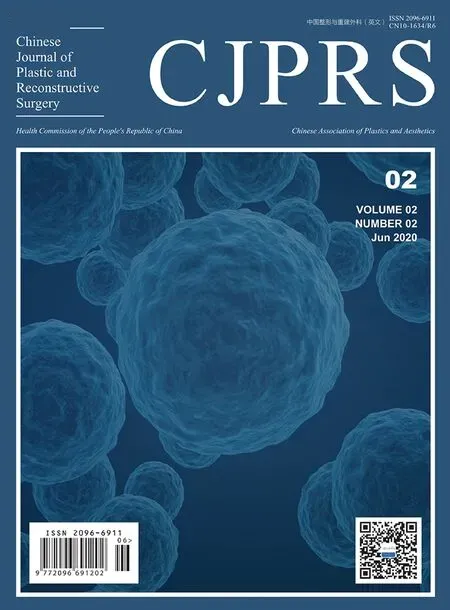A Case of Coexistence of Aplasia Cutis Congenita and Giant Congenital Melanocytic Nevus:Coexistence of Two Rare Skin Diseases
2020-08-29PingCHENLianshengZHONG
Ping CHEN ,Liansheng ZHONG
The author's OR CID number:https://orcid.org/0000-0001-8642-4653 (Lian-sheng ZHONG)
The authors' institutional affiliations:1 Department of Dermatology,XuZhou Children's Hospital,XuZhou,China.2 Department of Dermatology,Children's hospital of Fudan University Xiamen Branch,Xiamen,China.
ABSTRACT Aplasia cutis congenita (ACC) is a rare disease that is characterized by complete or partial absence of skin at birth,either in a localized or widespread region.Melanocytic nevi refers to tumor-like malformations of the skin or mucous membrane caused by benign proliferation of melanocytes.It is classified as a giant congenital melanocytic nevus(GCMN) when the diameter of the largest nevus exceeds 20 cm.The co-occurrence of ACC and GCMN is extremely rare,to the best of our knowledge.We report a case of coexistence of ACC and GCMN of infancy in a 2-month-old male infant.The lesions consisted of a large hyperpigmented plaque occupying most of the trunk and pelvic region,and smaller hyperpigmented plaques on the trunk,head,and extremities.Additionally,there were large,sharply marginated,triangular,depressed atrophic plaques covered by thin,translucent,glistening epithelial membranes in the center of the GCMN on the back.The presumptive diagnosis was coexistence of GCMN and ACC.This could be a manifestation of SCALP syndrome,a rare neuro-cutaneous condition characterized by the presence of Sebaceous nevus,Central nervous system (CNS) malformations,Aplasia cutis congenita,Limbal dermoid and Pigmented (giant melanocytic) nevus.
KEY WORDS Aplasia cutis congenita; giant congenital melanocytic nevus; neurocutaneous melanosis;melanoma
INTRODUCTION
Aplasia cutis congenita (ACC) is a rare disease characterized by complete or partial absence of skin at birth,either in a localized or widespread area.Melanocytic nevi refer to tumor-like malformations of the skin or mucous membrane due to benign proliferation of melanocytes.A melanocytic nevus is classified as a giant congenital melanocytic nevus (GCMN) if the diameter of the largest nevus exceeds 20 cm.The concurrence of ACC and GCMN is extremely rare,to the best of our knowledge.We report a case of ACC and GCMN of infancy in a 2-month-old male infant.
CASE REPORT
A 2-month-old male infant presented to the outpatient clinic of dermatology at XuZhou Children's Hospital,China,with large,pigmented,irregular lesions occupying a large portion of his trunk and pelvic region with a large,depressed,atrophic lesion on his back.The pigmented lesion was present at birth and had been growing proportionately along with the growth of the child.The boy was also found to have a large,sharply marginated,triangular ulcer in the center of the GCMN on his back at birth,which resolved spontaneously within 5 weeks without any medical intervention.Physical examination revealed a large hyperpigmented plaque nevus covering a large part of the trunk and pelvic region,along with smaller hyperpigmented plaques located on the trunk,head,and extremities.Additionally,there were large,sharply marginated,triangular,depressed,atrophic plaques covered by thin,translucent,glistening,epithelial membranes in the center of the GCMN on his back.He was born to young parents with no consanguinity or known medical problems,at full-term via spontaneous vaginal delivery after an uncomplicated pregnancy.The newborn was otherwise healthy,with an APGAR score of 10 at birth.He did not have any other congenital defects.Ultrasound of the skin and Computed tomographic (CT)scanning of the head revealed no abnormalities.Routine investigations were normal.No definite pathogenic variation was found in sequencing of Medical Exome Genes in Hereditary Diseases.The presumptive diagnosis was coexistence of GCMN and ACC.
DISCUSSION
Congenital melanocytic nevi (CMN) are pigmented skin lesions formed by melanocytes,which may be present at birth or develop after a few weeks of life.Although CMN are relatively common,GCMN is a rare entity with an incidence of 1 in 20,000 to 500,000 live births[1].In addition,GCMN is of interest because of its association with potentially severe complications such as melanoma and neurocutaneous melanosis,due to central nervous system involvement[2].
Aplasia cutis congenita (ACC) is a rare malformation characterized by localized absence of the skin predominantly on the scalp,but sometimes on other parts of the body[3].In a majority of cases,the evolution is without complications and simple wound care is suitable.Complications (such as hemorrhage,local infection,meningitis,or more severe sagittal sinus thrombosis)that can aggravate the prognosis are rarely reported.There have been reports of occurrence of seizure and psychomotor retardation.[4,5]
Several abnormalities associated with GCMN have been previously reported.These include neurocutaneous melanocytosis,spina bifida occulta,meningocoele,club foot,neurofibromatosis,lipomatosis,and hypertrophy and atrophy of limbs.[6]There have been a few reports of epidermal nevus syndrome,Carney complex,premature aging syndromes,and ambiguous genitalia being associated with GCMN.[7,8]Our case highlights a new association of GCMN with ACC,and this may be a manifestation of the SCALP syndrome,a rare neurocutaneous condition characterized by the presence of Sebaceous nevus,Central nervous system (CNS)malformations,Aplasia cutis congenita,Limbal dermoid and Pigmented (giant melanocytic) nevus.[9]
Patients with giant congenital melanocytic nevus have an increased risk of CNS melanoma and symptomatic neurocutaneous melanosis,and therefore,long term follow-up is essential.
杂志排行
Chinese Journal of Plastic and Reconstructive Surgery的其它文章
- Diagnosis and Treatment of Axillary Web Syndrome:An Overview
- Regenerative Therapeutic Applications of Mechanized Lipoaspirate Derivatives
- Biomaterial Scaffolds for Improving Vascularization During Skin Flap Regeneration
- Pedicled or Free Flap from Contralateral Breast for Autologous Breast Reconstruction
- A Novel Method for the Prenatal Diagnosis of Cleft Palate Based on Amniotic Fluid Metabolites
- Comprehensive Strategy for Keloid Treatment:Experience at Shanghai Ninth People's Hospital
